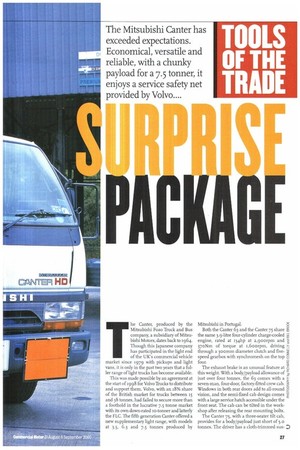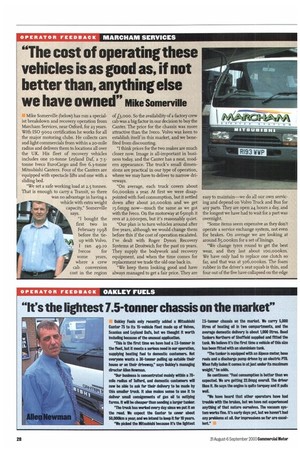T he Canter, produced by the Mitsubishi Fuso Truck and Bus
Page 29

Page 30

Page 31

If you've noticed an error in this article please click here to report it so we can fix it.
company, a subsidiary of Mitsubishi Motors, dates back to 1964. Though this Japanese company has participated in the light end of the UK's commercial vehicle market since 1979 with pickups and light vans, it is only in the past two years that a fuller range of light trucks has become available.
This was made possible by an agreement at the start ofi998 for Volvo Trucks to distribute and support them. Volvo, with an 18% share of the British market for trucks between 15 and 38 tonnes, had failed to secure more than a foothold in the lucrative 7.5 tonne market with its own down-rated to-tower and latterly the FLC. The fifth generation Canter offered a new supplementary light range, with models at 3.5, 6.3 and 7.5 tonnes produced by Mitsubishi in Portugal.
Both the Canter 63 and the Canter 75 share cz the same 3.9-litre four-cylinder charge-cooled c4; engine, rated at 134hp at 2,9oorpm and 37oNm of torque at r,600rpm, driving through a 3 oomm diameter clutch and fivespeed gearbox with synchromesh on the top 8 four.
The exhaust brake is an unusual feature at E
this weight. With a body/payload allowance of c,c, just over four tonnes, the 63 comes with a seven-man, four-door, factory-fitted crew cab. It Windows in both rear doors add to all-round vision, and the semi-fixed cab design comes with a large service hatch accessible under the front seat. The cab can be tilted in the workshop after releasing the rear mounting bolts.
The Canter 75, with a three-seater tilt cab, provides for a body/payload just short of 5.o tonnes. The driver has a cloth-trimmed sus
Mike Somerville (below) has run a specialist breakdown and recovery operation from Marcham Services, near Oxford, for 23 years. With ISO 9002 certification he works for all the major motoring clubs. He collects cars and light commercials from within a 2o-mile radius and delivers them to locations all over the UK. His fleet of recovery vehicles includes one to-tonne Leyland Daf, a 7.tonne Neu) EuroCargo and five 6.3-tonne Mitsubishi Canters. Four of the Canters are equipped with spectacle lifts and one with a sliding bed.
"We set a safe working load at 2.5 tonnes. That is enough to carry a Transit, so there was no advantage in having a vehicle with extra weight capacity," Somerville says.
"I bought the first two in February 1998 before the tieup with Volvo. I ran 49.10 Ivecos for some years, where a crew cab conversion cost in the region of /3, 000. So the availability of a factory crew cab was a big factor in our decision to buy the Canter. The price for the chassis was more attractive than the Iveco. Volvo was keen to establish itself in this market, and we benefited from discounting.
"I think prices for the two makes are much closer now. Image is all-important in business today, and the Canter has a neat, modem appearance. The truck's small dimensions are practical in our type of operation, where we may have to deliver to narrow driveways.
"On average, each truck covers about 6o,000km a year. At first we were disappointed with fuel consumption, but it settled down after about 20,000km and we get 15.6mpg now—much the same as we got with the Iveco. On the motorway at 65mph it revs at 2,000rpm, but it's reasonably quiet.
"Our plan is to turn vehicles around after five years, although we would change them before this if the cost of operation escalated. I've dealt with Roger Dyson Recovery Systems at Droitwich for the past to years. They supply the bodywork and recovery equipment, and when the time comes for replacement we trade the old one back in.
"We keep them looking good and have always managed to get a fair price. They are easy to maintain—we do all our own servicing and depend on Volvo Truck and Bus for any parts. They are open 24 hours a day, and the longest we have had to wait for a part was overnight.
"Some items seem expensive as they don't operate a service exchange system, not even for brakes. On average we are looking at around 85,000km for a set of linings.
-We change tyres round to get the best wear, and they last about roo,000km. We have only had to replace one clutch so far, and that was at 306,000lcm. The foam rubber in the driver's seat squab is thin, and four out of the five have collapsed on the edge nearest the door. It's about £30 to replace.
"Based on our experience, I think we will stay with the Canter, but I would like to see some changes. An air rather than hydraulic braking system would be more up to date, along with spring brakes for parking. We do a lot of winching and the umbrella lever is just not up to the job.
The cab is big enough for the driver and comfortable and quiet for the customers to ride in. The steering adjusts for height and rake and there is plenty of leg room for everyone. The cost of operating these vehicles is as good as, if not better than, anything we have owned."
pension seat, and steering is adjustable for both height and rake, The stubby gear lever and umbrella-type park brake lever allow a reasonable degree of cross-cab access. Glove boxes and large door pockets provide stowage space, and a clipboard is concealed in the rear of the central seat back.
When CM tested it in June i999 with a Ken Kerr curtainsided body, the 7.5-tonner weighed in with a payload of 425 tonnes. We concluded that top was slightly under-geared for motorway work, but also that the engine was not sufficiently powerful to pull a higher gear.
However, in town, the engine proved impressively flexible. The ride was unexceptional, and the front body roll became excessive if driven through roundabouts too fast. Brakes are effective and engine braking is strong. The umbrella-type park brake has a long travel.
At the beginning of this year Volvo announced a number of improvements to the range, with a crew cab option for the 75 and a three-man tilt cab for the 63. Both have central locking as standard, while air conditioning and ABS are included in an option pack. A wider choice of wheelbases adds to the models' versatility. New heavy-duty shock absorbers have been added to improve handling, and an aluminium gearbox casing pares 20kg off the unladen weight. The latest versions also have disc front brakes.
• by Bill Brock












































































































